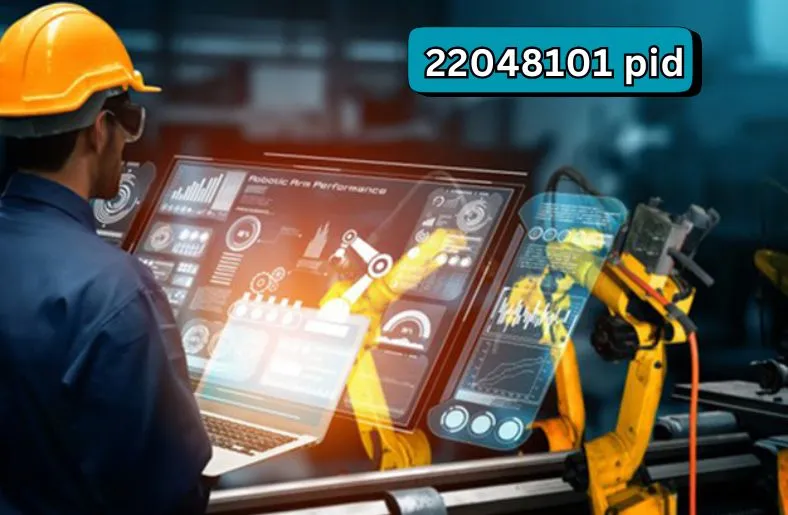Introduction
In today’s world, industries rely heavily on automation to keep processes running smoothly. One essential tool in this area is the PID controller. PID stands for Proportional, Integral, and Derivative. This device helps maintain control over important factors like temperature and pressure. By ensuring these variables stay consistent, 22048101 PID controllers improve efficiency and safety in various industries.
Among the many PID controllers available, the 22048101 PID model stands out. It is known for its accuracy and reliability. Industries use this specific controller to optimize their operations. With advanced features, the 22048101 PID can adjust to different conditions. This makes it a valuable asset in manufacturing, food processing, and chemical plants.
Understanding how the 22048101 PID works is crucial for engineers and technicians. It helps them make better decisions about their automation systems. In this article, we will explore the key aspects of the 22048101 PID. We will discuss its features, applications, and benefits. By the end, you will see why this controller is essential for optimizing industrial automation.
Understanding PID Controllers
PID controllers are vital tools in industrial automation. They help maintain specific conditions in processes, such as temperature or pressure. The term PID stands for Proportional, Integral, and Derivative, which describe the three control actions used by these devices.
- First, the Proportional part adjusts the output based on the current error. This error is the difference between the desired set point and the actual value. By responding to this error, the controller makes quick adjustments. As a result, it helps bring the process back to the desired level.
- Next, the Integral component focuses on past errors. It accumulates these errors over time and adjusts the output accordingly. This action corrects any long-term discrepancies, ensuring the process stays stable. Without this feature, small errors could add up and cause significant issues.
- Finally, the Derivative part predicts future errors. It does this by analyzing how quickly the error changes. By understanding these trends, the controller can act before problems occur. This predictive ability helps keep the process smooth and efficient.
In summary, PID controllers are essential for managing industrial processes. They work by adjusting outputs based on current, past, and future errors. This balanced approach allows for precise control, leading to improved efficiency and safety in various applications. Understanding these controllers is crucial for anyone involved in automation.
What is 22048101 PID?
The 22048101 PID is a specific model of a PID controller used in industrial settings. It is designed to regulate important process variables, such as temperature, pressure, and flow. This controller helps keep these variables stable, ensuring that systems operate efficiently.
- One key feature of the 22048101 PID is its accuracy. It can make precise adjustments based on real-time data. This capability is essential in environments where even small changes can affect product quality. For example, in food processing, maintaining the right temperature is crucial for safety and quality.
- Additionally, the 22048101 PID is user-friendly. Operators can easily set and adjust their parameters. This ease of use allows technicians to focus on other tasks, knowing the controller will manage process stability. Its interface is straightforward, making it accessible even for those with limited technical experience.
- Moreover, this PID controller is versatile. It can be used in various industries, including pharmaceuticals, chemical processing, and manufacturing. Its ability to integrate with other automation systems makes it a popular choice among engineers.
In summary, the 22048101 PID is an advanced tool in industrial automation. Its precision, ease of use, and versatility make it ideal for regulating critical processes. By understanding this specific model, industries can enhance their operations and achieve better efficiency.
Core Features of 22048101 PID
The 22048101 PID controller has several key features that make it stand out.
- First, it offers precise control over process variables. This accuracy is crucial in industries where small changes can lead to big problems. For instance, in a chemical plant, precise temperature control ensures safe and efficient operations.
- Next, the 22048101 PID is designed for ease of use. It has a simple interface, allowing operators to set and adjust parameters quickly. Even those with little technical knowledge can operate it effectively. This user-friendly design saves time and reduces errors during operation.
- Another important feature is its versatility. The 22048101 PID can be applied in various industries, including food processing, pharmaceuticals, and manufacturing. This adaptability makes it a popular choice among engineers. They can use it in different settings without needing extensive modifications.
- Furthermore, this controller promotes energy efficiency. By optimizing processes, it helps reduce energy costs. Businesses benefit from lower utility bills and a smaller carbon footprint. This feature is increasingly important in today’s environmentally conscious world.
- Lastly, the 22048101 PID ensures reliable performance. It is built with durable components that withstand harsh industrial conditions. This reliability reduces the need for frequent maintenance and downtime, keeping operations running smoothly.
In summary, the 22048101 PID controller combines precision, user-friendliness, versatility, energy efficiency, and reliability. These features make it an excellent choice for optimizing industrial automation.
Applications of 22048101 PID in Industries
The 22048101 PID controller finds many uses in different industries. One common application is in temperature control. For example, in food processing plants, maintaining a specific temperature is vital. The 22048101 PID ensures that ovens and refrigerators operate at the right temperatures. This helps keep food safe and fresh. Without proper temperature control, food can spoil, leading to waste and health risks.
Another important application is in chemical processing. In this industry, controlling pressure and temperature is crucial. The 22048101 PID regulates these variables to ensure safe reactions. For instance, a chemical reactor keeps the temperature steady. This stability prevents dangerous situations, such as explosions. By managing these conditions, the 22048101 PID helps to ensure the safety of workers and equipment.
Additionally, the 22048101 PID is essential in manufacturing processes. It regulates the flow rates of liquids and gases in production lines. This control ensures that materials are delivered consistently and accurately. For example, in an oil refinery, the PID controller manages the flow of crude oil through pipelines. This precision reduces waste and increases efficiency in production.
Lastly, the 22048101 PID is useful in HVAC systems. It controls heating, ventilation, and air conditioning to maintain comfortable indoor environments. By adjusting the temperature and airflow, it helps save energy and improve comfort. This application is especially important in large buildings, where temperature control can significantly impact energy use.
In summary, the 22048101 PID controller is versatile and widely used across industries. Its applications in temperature control, chemical processing, manufacturing, and HVAC systems demonstrate its importance. This controller plays a key role in optimizing operations and ensuring safety in various environments.
Setting Up 22048101 PID for Optimal Performance
To get the best results from your 22048101 PID controller, proper setup is crucial.
- First, ensure you install the controller in a suitable location. It should be away from strong vibrations and direct sunlight. This helps prevent interference and keeps the readings accurate.
- Next, calibrate the system. Calibration involves adjusting the PID parameters to match your specific process needs. Start by setting the proportional, integral, and derivative values. These settings control how the system reacts to changes. Adjust them carefully to find the right balance for your process.
- After calibration, monitor the system closely. Check the performance regularly to ensure everything runs smoothly. If you notice any irregularities, fine-tune the parameters as needed. This step is vital for maintaining optimal performance over time.
- Finally, keep an eye on the maintenance needs. Regularly inspect the PID controller for wear and tear. Performing routine checks will help extend the controller’s life. In conclusion, setting up the 22048101 PID correctly leads to better efficiency and reliability in your industrial processes.
Following these steps will help you achieve consistent results and optimal performance.
Common Challenges and Solutions
Using the 22048101 PID controller can present some challenges.
- One common issue is overshooting the set point. This happens when the system goes beyond the desired level. To solve this, you can adjust the proportional gain. Lowering this value helps the system stabilize faster.
- Another challenge is slow response time. If the system takes too long to react, it may lead to inefficiencies. In this case, increasing the proportional gain can improve responsiveness. It helps the controller react quickly to changes in the process.
- Fluctuating process variables can also be a problem. This occurs when the measured value keeps bouncing around the set point. To address this, adjusting the derivative gain is helpful. Increasing this value can dampen the oscillations and create a smoother response.
- Lastly, calibration errors may cause inaccurate readings. Regularly check and recalibrate your system to avoid this issue. Accurate calibration ensures that the controller works correctly.
By addressing these common challenges, you can maintain optimal performance with the 22048101 PID controller and enhance your industrial processes.
Future of 22048101 PID in Industrial Automation
The future of the 22048101 PID controller in industrial automation looks promising.
- As technology evolves, these controllers will become smarter and more efficient. They will integrate better with advanced systems, like the Internet of Things (IoT). This connection will allow for real-time monitoring and control.
- Moreover, artificial intelligence (AI) will play a significant role. AI can analyze data quickly and adjust settings automatically. This will enhance the accuracy of the 22048101 PID controller even further. Companies will benefit from improved efficiency and lower energy costs.
- Additionally, industries will focus more on sustainability. The 22048101 PID can help reduce waste and energy use. By optimizing processes, it supports eco-friendly practices.
In conclusion, the 22048101 PID controller will continue to be vital. Its future in industrial automation is bright, promising better performance and sustainability for various sectors.
Conclusion
In summary, the 22048101 PID controller is essential for optimizing industrial automation. Its precise control, ease of use, and versatility make it a valuable tool across various industries. By understanding its core features and applications, businesses can enhance efficiency and safety in their processes. While challenges may arise, proper setup and maintenance can ensure optimal performance. As technology advances, the future of the 22048101 PID looks bright, with increased integration into smart systems and a focus on sustainability. Embracing this controller will lead to better operations and a more sustainable industrial landscape.




